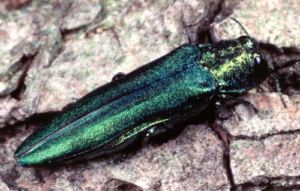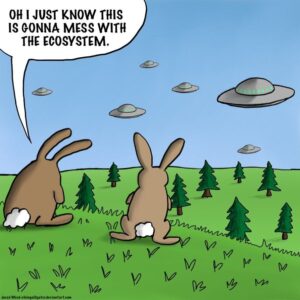Imagine going about your day as usual, and an aggressive alien presence slowly starts to take away the resources you need to thrive, deteriorating your livelihood and threaten your ability to carry on your own kind. Scary right? Well this is exactly what invasive, introduced, species do to the native species in our environment.
Different types of alien plants, animals, birds, aquatic critters, and bugs can each play a part in the decline of the beneficial, healthy, native species in any natural area, like the Meewasin Valley. Invasive species are the second most significant threat to biodiversity, which provides functioning ecosystems that supply oxygen, clean air and water, pollination of plants, pest control, wastewater treatment and many other ecosystem services, in addition to the recreation activities of various wildlife watching activities!
In honour of Invasive Species Week from February 22 to February 26, 2021, we are featuring some of the most detrimental invasive species in the Prairie Provinces: Prussian Carp, European Buckthorn, Emerald Ash Borer, and Wild Boar (Feral Pigs).
The Cloning Fish – Prussian Carp
Prussian Carp is an invasive species that can clone itself. Yep you read that right CLONE itself! And no… it isn’t part of a sci-fi movie plot! Prussian Carp is an invasive fish species that is actually able to clone itself through a process called gynogenesis – making each individual fish an exact duplicate. Prussian Carp steal milt from related species found floating around in rivers and lakes, but doesn’t actually contribute any genetic material. This is part of the reason why it can be so detrimental to native species, since the carp is taking the milt of fish that might otherwise be used to fertilize their own species.
able to clone itself through a process called gynogenesis – making each individual fish an exact duplicate. Prussian Carp steal milt from related species found floating around in rivers and lakes, but doesn’t actually contribute any genetic material. This is part of the reason why it can be so detrimental to native species, since the carp is taking the milt of fish that might otherwise be used to fertilize their own species.
Prussian Carp are even more dangerous as they can live up to 10 years, lay almost 1 million eggs in a year, out compete native fish for food sources, and can survive extreme environmental conditions, such as low oxygen levels or high amounts of algae. Other interesting fact is that Prussian Carp are so closely related to goldfish that you have to use genetics to tell them apart! They have also been tested for use in commercial fish sticks in Pakistan.
The Bad Berry – European Buckthorn
European (Common) Buckthorn (Rhamnus carthartica) is a deciduous small tree or shrub, native to Europe prevalent in riparian forests of the Meewasin Valley, urban parks, natural areas, and in backyards within Saskatoon and surrounding area. These trees or shrubs crowd and shade out native understory plants, eventually displacing native trees and shrubs. It has been found up to 60 km north, 20 km south and throughout the City of Saskatoon, and spreads very quickly.
backyards within Saskatoon and surrounding area. These trees or shrubs crowd and shade out native understory plants, eventually displacing native trees and shrubs. It has been found up to 60 km north, 20 km south and throughout the City of Saskatoon, and spreads very quickly.
Although it looks like a tasty, nutritious berry, humans, mammals, rodents and birds alike actually cannot digest European Buckthorn berries as they contain a strong laxative that causes birds to expel the seeds after only about one hour after ingesting. Because of the easy spread of them, Meewasin works hard to control this invasive species as soon as it’s identified in the Meewasin Valley. Over the last 20 years, Meewasin has controlled well over 2 million stems of European Buckthorn! Check out our conservation page for more information about our efforts and program to control European Buckthorn.
The Boring Beetle – Emerald Ashborer

Emrald Ashborer is a metallic, wood-boring beetle native to East Asia and is spread primarily by the movement of infested firewood. Stopping the movement of infested firewood is very important because once infested firewood is introduced, it is very difficult to detect and manage. The adult beetles can fly, and spread locally. Up to 99% of all ash trees are killed within 8-10 years once the beetle arrives in an area. (1) After an infestation, remaining beetles can kill new growth as well, which jeopardizes forest recovery.
Ash trees are what helps give shade and tree cover in Saskatoon and similar areas, so this beetle’s presence would be devastating to the urban forest in Saskatoon, in addition to homeowner heating/cooling costs, and air quality. (1) Ash are as common as elm and we have already lost a number of elm because of another invasive pest, the cottony ash psyllid. Populations of Emerald Ashborer exist in Manitoba, but currently Saskatchewan does not have any reports of it, so let’s keep it that way!
The Appalling Pigs – Wild Boar

There are no native pig species in Canada but we now have many of them here in Saskatchewan. Wild boar were imported to Canada in the 1980s and 1990s to be raised on farms but they escaped into the wild and have adapted for forested, wetland, and riverbank habitats which are negatively impacted and adversely affect nesting birds and other wildlife species.
Many thought that wild boar would never survive a Saskatchewan winter, but they are large (up to 300 kg or about 600 pounds!) and very furry, and make “pigloos” in the snow to stay warm during the winter season. These “pigloos” are made by the pigs mounding cattails and burrowing deep into the snow caught by the cattails, creating tunnels within it and using the snow as insulation. There have not yet been any confirmed sightings in Saskatoon but there have been many in the surrounding area and we know they can readily adapt to urban environments.
Wild Boar are reproducing quickly and expanding their range extensively. Their combination of wild and domestic traits — including their high tolerance for cold and ability to birth large litters — may have bred “super pigs,” says Ryan Brook, a wildlife researcher with the University of Saskatchewan. (3) “The growing wild pig population is not an ecological disaster waiting to happen,” Ryan Brook, the University of Saskatchewan’s lead researcher for the Canadian Wild Pig Project told USask News, “it is already happening.” (2)
If you happen to see a wild pig, be cautious as you would with any other large mammal like a moose or a cougar. Leave the area and report the observation. Call 911 if there is an immediate threat. In most cases wild pigs will avoid you and run away.
Conclusion
Many invasive species can become extremely damaging to native species, which is why it is so important to take action against them as soon as they are identified in a local setting. Part of Meewasin’s conservation work is focused on early detection and controlling these invasive species  to limit their spread and effect on the local wildlife populations and biodiversity.
to limit their spread and effect on the local wildlife populations and biodiversity.
These different types of alien plant, mammal, aquatic, and bug species can each play a part in the decline of the beneficial, healthy, native species in the nature that you enjoy. Because invasive species are the second most significant threat to biodiversity, please report any species at the Government of Saskatchewan’s reporting and tracking webpage, or the iMap invasives app, and join Meewasin’s volunteer list to hear about upcoming opportunities to get involved in invasive species removal activities.
We would like to thank Shayna Hamilton, Jeff Boone, and Dr. Ryan Brooks for contributing information to this blog.
Find more information about invasive species in Saskatchewan HERE. In addition, more species-specific information about invasives across the prairies can be found HERE
References
(3) https://www.trappermag.com/article-index/huge-feral-hogs-creating-pigloos-throughout-canada




